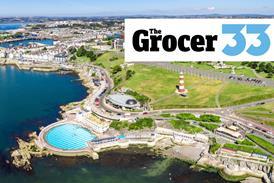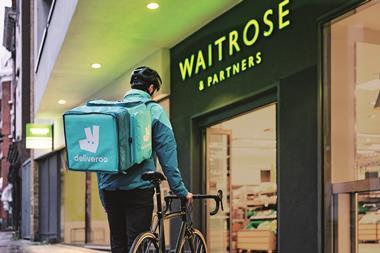Roger Whiteside is transforming Thresher into a multi-format force to be reckoned with. Julian Hunt meets him
Under-estimate Thresher Group at your peril. That’s the message from new chief executive Roger Whiteside to those who still think of the chain as a ragbag collection of 2,000 off-licences trading under half a dozen different fascias. As Whiteside points out, this is a business being transformed into a multi-format retail operation with a new emphasis on convenience. And, he says, the more established c-store operators had better watch out.
Much of the thinking that now underpins the Thresher strategy was agreed before Whiteside joined the business from online retailer Ocado in April. But the strategy clearly excites him and he feels his retail and food experience at Ocado and M& S makes him ideally qualified to steer the business through the latest stage of what is proving to be a massive turnaround project.
“The specialist off-licence sector faces a conundrum,” he explains. “Off-trade sales are rising as people consume more alcohol at home, but the market share of the specialist off-licences has been declining at the expense of supermarkets and other multiple c-stores. The strategic leap made before I arrived was that a business of 2,000 off-licences was not sustainable and needed to be transformed into a multi-format chain.”
In other words, he says, the business needs to be repositioned so that it has a foot in both the convenience and off-licence camps. As a result, the Thresher estate has been divided into two divisions. There’s the wine division which represents about 60% of stores, all of which will be branded Thresher and which meet the needs of a relatively affluent customer base. Then there’s the drinks division, which represents the rest of the Thresher estate, and which has a more traditional beer and fags customer base.
Within these two divisions there is plenty of work under way developing the right formats to meet the needs of local shoppers; there’s the T23, which is an upgraded off-licence concept; Thresher Plus Food, which offers Leapingsalmon premium meal kits; and then there’s The Local.
The latter is a pilot concept designed to turn traditional off-licences into what Whiteside has dubbed micro convenience stores. “Research says that people are driven to our off-licences by the need to pick up a packet of fags or a four-pack for immediate consumption, and they are heavy visitors of local convenience parades,” he says.
Thresher wants to use The Local to tap into that dynamic by offering the core off-licence range as well as new categories such as chilled snacks, sandwiches, replenishment grocery lines or DVD rental.
The exact range on offer in these stores, which are typically 700 sq ft to 1,000 sq ft in size, will be based on what shoppers in the area actually need, says Whiteside, thus avoiding a one-size-fits-all approach.
He adds: “Just as the multiples see an opportunity to get into convenience, we believe there’s an opportunity for us at a store size level that is not attractive to them. Sainsbury and Tesco have looked over the cliff of 1,500 sq ft and thought ‘we do not fancy that’. We are a specialist in really small store retailing and the retailing challenges of running a chain of 2,000 stores are very different to running big box retail units, so we think we can leverage our core skills.”
Similar thinking underpins the Thresher Plus concept, which is all about adding new categories to complement the wine being sold. Whiteside explains: “Typically shoppers are looking for something to eat so we have created a range of prepared meal solutions that are targeted at the quality end of the market. We are learning as we go and there will be further developments as we gain more experience of what our consumers want and there’s a growing awareness that we actually sell food. We need to get people to recognise the fact there’s an alternative premium choice in a sea of mediocrity.”
It’s still early days for all these concepts, which Whiteside says he will continue to evolve and develop. There are 11 Thresher Plus stores open, with 80 more due to roll out next month, and the company will have more than 50 T23s within the M25 by the end of this year. The Local is on trial in four stores in Scotland and will be tested south of the border.
“Our biggest risk is execution,” admits Whiteside. “The strategy is right. Being just a specialist off-licence is not sustainable. Convenience is a growing market so we are moving towards consumer needs. Can we position ourselves there and compete successfully with others who have seen the same opportunity? That’s our test. And our biggest challenge is that we are doing this in stores at sub-1,000 sq ft.”
Not all the work under way at Thresher is front of the house stuff. There’s plenty going on behind the scenes, too. A new regional management structure has been introduced to improve retail execution and support the introduction of a new selling programme dubbed WASP. Thresher is also about to roll out sales-based ordering to all stores by the end of the year, and it is still reviewing its EPoS needs in the light of Chip and PIN.
The change happening at Thresher is massive. While there are those who point out its profits have yet to recover to the levels recorded before the merger of Thresher and Victoria Wine in the mid-1990s, the chain is back in the black and there is no denying its ambitions or those of its private equity backer Terra Firma. For starters, there are the inevitable rumours relating to a possible deal for Unwins. And then Whiteside confirms Thresher was interested in doing a deal for Londis: “That would have fitted in with our strategy of trying to reposition ourselves and develop into convenience.”
He adds: “People do underestimate where we are in the scheme of things. We have turnover of £1bn, which is not to be sniffed at, plus 2,000 shops and we employ 12,5000 people. It’s Spar, the Co-op, Londis and then us. We are a big player in this.”
And Whiteside, for one, is clearly keen to see Thresher get even bigger.
Under-estimate Thresher Group at your peril. That’s the message from new chief executive Roger Whiteside to those who still think of the chain as a ragbag collection of 2,000 off-licences trading under half a dozen different fascias. As Whiteside points out, this is a business being transformed into a multi-format retail operation with a new emphasis on convenience. And, he says, the more established c-store operators had better watch out.
Much of the thinking that now underpins the Thresher strategy was agreed before Whiteside joined the business from online retailer Ocado in April. But the strategy clearly excites him and he feels his retail and food experience at Ocado and M& S makes him ideally qualified to steer the business through the latest stage of what is proving to be a massive turnaround project.
“The specialist off-licence sector faces a conundrum,” he explains. “Off-trade sales are rising as people consume more alcohol at home, but the market share of the specialist off-licences has been declining at the expense of supermarkets and other multiple c-stores. The strategic leap made before I arrived was that a business of 2,000 off-licences was not sustainable and needed to be transformed into a multi-format chain.”
In other words, he says, the business needs to be repositioned so that it has a foot in both the convenience and off-licence camps. As a result, the Thresher estate has been divided into two divisions. There’s the wine division which represents about 60% of stores, all of which will be branded Thresher and which meet the needs of a relatively affluent customer base. Then there’s the drinks division, which represents the rest of the Thresher estate, and which has a more traditional beer and fags customer base.
Within these two divisions there is plenty of work under way developing the right formats to meet the needs of local shoppers; there’s the T23, which is an upgraded off-licence concept; Thresher Plus Food, which offers Leapingsalmon premium meal kits; and then there’s The Local.
The latter is a pilot concept designed to turn traditional off-licences into what Whiteside has dubbed micro convenience stores. “Research says that people are driven to our off-licences by the need to pick up a packet of fags or a four-pack for immediate consumption, and they are heavy visitors of local convenience parades,” he says.
Thresher wants to use The Local to tap into that dynamic by offering the core off-licence range as well as new categories such as chilled snacks, sandwiches, replenishment grocery lines or DVD rental.
The exact range on offer in these stores, which are typically 700 sq ft to 1,000 sq ft in size, will be based on what shoppers in the area actually need, says Whiteside, thus avoiding a one-size-fits-all approach.
He adds: “Just as the multiples see an opportunity to get into convenience, we believe there’s an opportunity for us at a store size level that is not attractive to them. Sainsbury and Tesco have looked over the cliff of 1,500 sq ft and thought ‘we do not fancy that’. We are a specialist in really small store retailing and the retailing challenges of running a chain of 2,000 stores are very different to running big box retail units, so we think we can leverage our core skills.”
Similar thinking underpins the Thresher Plus concept, which is all about adding new categories to complement the wine being sold. Whiteside explains: “Typically shoppers are looking for something to eat so we have created a range of prepared meal solutions that are targeted at the quality end of the market. We are learning as we go and there will be further developments as we gain more experience of what our consumers want and there’s a growing awareness that we actually sell food. We need to get people to recognise the fact there’s an alternative premium choice in a sea of mediocrity.”
It’s still early days for all these concepts, which Whiteside says he will continue to evolve and develop. There are 11 Thresher Plus stores open, with 80 more due to roll out next month, and the company will have more than 50 T23s within the M25 by the end of this year. The Local is on trial in four stores in Scotland and will be tested south of the border.
“Our biggest risk is execution,” admits Whiteside. “The strategy is right. Being just a specialist off-licence is not sustainable. Convenience is a growing market so we are moving towards consumer needs. Can we position ourselves there and compete successfully with others who have seen the same opportunity? That’s our test. And our biggest challenge is that we are doing this in stores at sub-1,000 sq ft.”
Not all the work under way at Thresher is front of the house stuff. There’s plenty going on behind the scenes, too. A new regional management structure has been introduced to improve retail execution and support the introduction of a new selling programme dubbed WASP. Thresher is also about to roll out sales-based ordering to all stores by the end of the year, and it is still reviewing its EPoS needs in the light of Chip and PIN.
The change happening at Thresher is massive. While there are those who point out its profits have yet to recover to the levels recorded before the merger of Thresher and Victoria Wine in the mid-1990s, the chain is back in the black and there is no denying its ambitions or those of its private equity backer Terra Firma. For starters, there are the inevitable rumours relating to a possible deal for Unwins. And then Whiteside confirms Thresher was interested in doing a deal for Londis: “That would have fitted in with our strategy of trying to reposition ourselves and develop into convenience.”
He adds: “People do underestimate where we are in the scheme of things. We have turnover of £1bn, which is not to be sniffed at, plus 2,000 shops and we employ 12,5000 people. It’s Spar, the Co-op, Londis and then us. We are a big player in this.”
And Whiteside, for one, is clearly keen to see Thresher get even bigger.















No comments yet